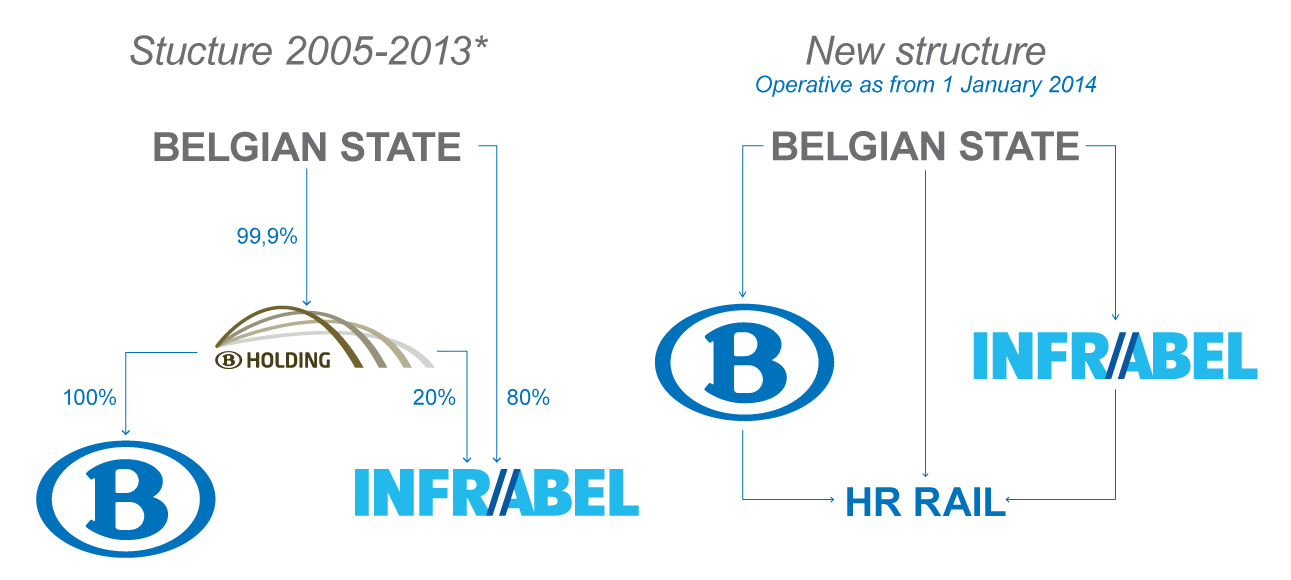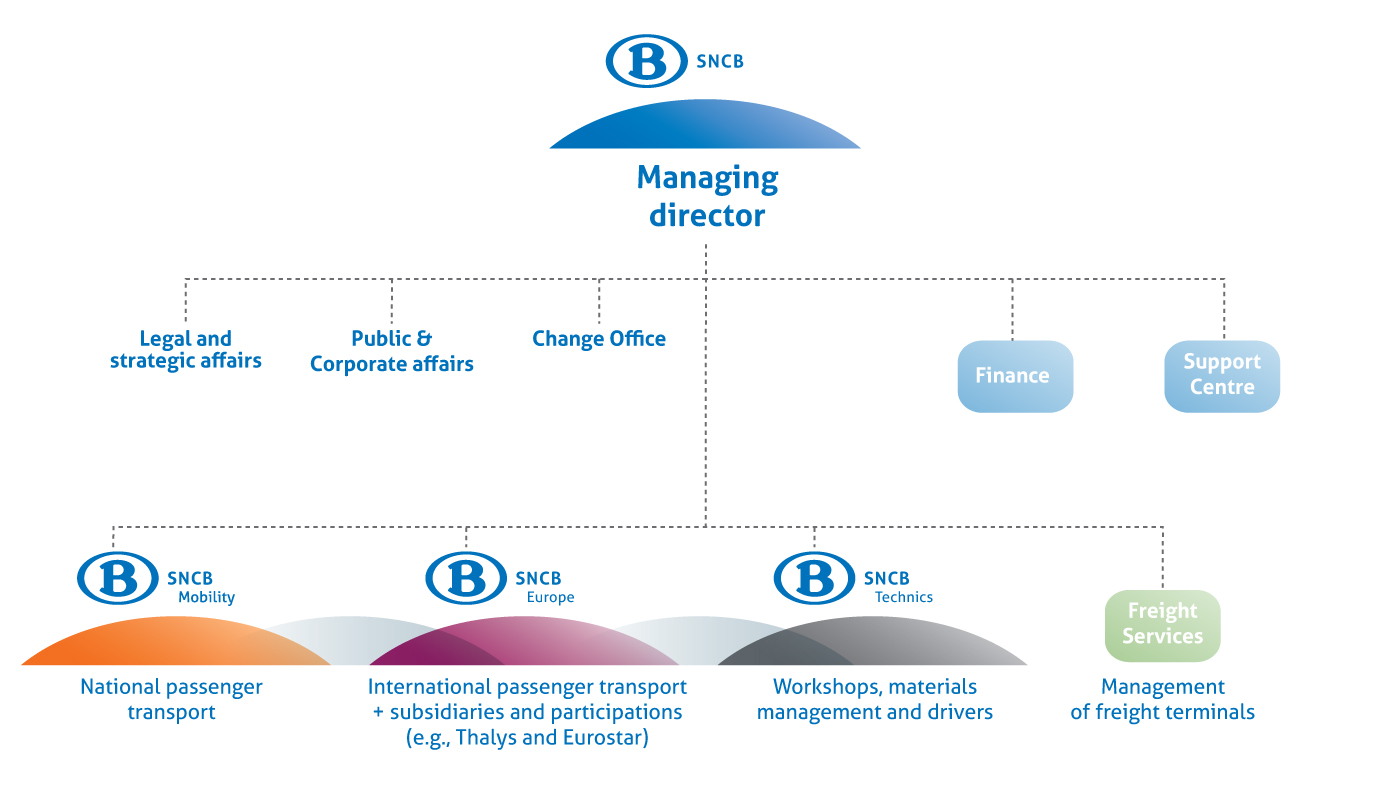Railways in Belgium
From 1926 (founding date of the SNCB) until 2005 Belgian railways formed a single unit. In 2005, activities were divided into three autonomous companies. SNCB-Holding took over responsibility for staff, computer technology, the 37 major stations and coordination between the three companies. Infrabel managed the infrastructure and was in charge of track maintenance, the modernisation of the network, signals and traffic management. SNCB, the transporter or operator, organised and commercialised the offer of trains (both national and international) and was in charge of the maintenance and modernisation of the rolling stock.
In early 2013, the federal government decided to simplify the structure of the railways.SNCB Holding has been abolished and greater clarification has been given to the distribution of tasks between SNCB and Infrabel.To put it concisely, SNCB will manage everything that concerns passengers (including the stations) and will be solely responsible for communication with passengers.Infrabel will focus on managing the infrastructure (operation, maintenance, modernisation etc.) and communication with railway operators such as SNCB.The staff of SNCB, Infrabel and HR Rail keep their former status.HR Rail is a specific company that functions as the sole employer.This restructuring will be implemented in the course of 2013, resulting in a new structure on 1 January 2014.

Stimulating competition
Traditionally, Belgian railways, as in most European countries, were a state monopoly. In other words, these companies were the only ones with the right to offer rail services on their national network. By promoting competition, the European Union hopes to improve the quality of the rail offer. It aims to achieve this by making a clear separation between management and infrastructure (the tracks) and operation of the train service.
Back in 1991, the European Union published its first directive to put an end to monopolies. Directive 91/440 obliged the Member States to separate (at least on the accountancy level) management from the infrastructure of transport activities.This directive and those that followed it began to liberalise** railways in several countries such as the Netherlands and Great Britain.The directives forbade the Member States to continue subsidising commercial activities such as freight transportation and international passenger travel. In Belgium, transport activities were not all liberalised at the same time. As regards freight transportation, competition became possible in 2003 for international links and in 2007 for all routes. International passenger traffic followed in 2010. National passenger traffic is still not open to competition, but this could change by 2017, although for the European Union no precise date has as yet been specified.
Structure of SNCB

Three departments
SNCB comprises three departments in charge of specific activities. During 2013, the planned restructuring will have an impact on the SNCB flowchart. SNCB will be given more tasks and responsibilities (particularly as regards the management of stations and information to passengers) and this will entail changes to the structure and to the tasks carried out by certain departments.
- SNCB Mobility:Manages national passenger traffic and everything connected with it. SNCB Mobility also manages the stations and is in charge of the management and training of attendants, sales staff and station staff.
- SNCB Europe: Organises international train traffic. SNCB Europe is also involved in certain subsidiaries that manage specific trains (Thalys and Eurostar) or aspects of international ticket sales.
- SNCB Technics:manages, maintains and modernises trains. SNCB Technics is also responsible for the planning and training of train drivers.
Other services
In addition to the three departments, there are three main services in SNCB. Finance manages the SNCB operational and investment budgets. Central Support deals with (large) orders and purchases of SNCB, the buildings and the human resources. SNCB Freight Services organises activities in freight terminals (sorting and formation of freight trains) for clients in the freight sector (above all, SNCB Logistics). The management and commercialisation of freight traffic are managed entirely by the subsidiary SNCB Logistics.
Like all companies, SNCB has some staff services for strategic business (business plan, management contract, etc), legal affairs and communication. By communication, you should not imagine announcements by microphone in stations or trains.The department of Public & Corporate Affairs manages contacts with the press***, the Corporate pages of the SNCB site, Web TV and brochures and publications. It is also in charge of internal communication via the Intraweb coordination for SNCB staff.
Our subsidiaries
SNCB possesses a certain number of subsidiaries of which it is the sole or partial shareholder. This makes it easy for SNCB to collaborate with national or foreign partners. The subsidiaries are mainly specialised in the field of freight transport or of international passenger transport.
SNCB Logistics is the largest subsidiary.n It commercialises and manages the transport of freight. It hires the services of Freight Services and SNCB Technics. The latter has three workshops for freight wagons which maintain and repair most of the locomotives of SNCB Logistics. SNCB Logistics also holds shares in a series of companies specialised in freight transportation. One of these is Xpedys, which organises transport of steel, mineral ore, semi-finished products and various industrial products. IFB deals with container transport and manages terminals.
As for international passenger transport, Thalys is certainly the best-known company. SNCB also holds a 5% participation in Eurostar.
*SNCB-Holding holds 100% of the shares of SNCB. The end owner of SNCB is thus the Federal State (or the taxpayer).
**Liberalisation means “opening up the market”. Thus, different companies may offer similar products on the same market. This means that public companies need not be privatised (transformed into a private company in which the State is no longer a shareholder).
**** SNCB has experienced spokespersons who are used to dealing with the media. If a journalist comes and asks you a question, do not try to reply but direct themto the spokesperson.

